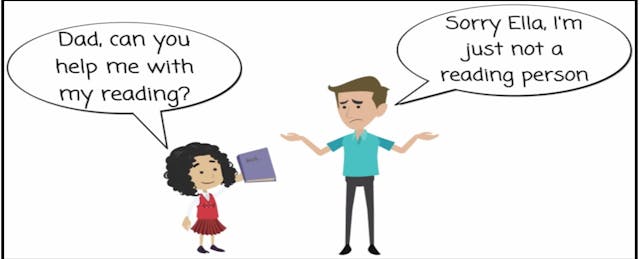Imagine a parent telling a child, “I’m just not a reading person.” Sounds odd, doesn’t it? Now reread the same cartoon, substituting “math” for “reading.” Suddenly it doesn’t seem so absurd. But it should!
It’s common to hear well educated adults declare themselves “not a math person,” sometimes proudly. Indeed, many people of all ages believe that mathematical ability is something you are either born with or not, rather than something to be mastered with focused effort. This belief is wrong. What’s more, it’s harmful to kids as they have their first experiences learning math; the attitude that “I can’t learn math” quickly becomes a self-fulfilling prophecy. As a society ever more reliant on technology and STEM-based careers, we must shatter the myth that math skill is inborn and reinforce that it is the result of intention and practice. Reforming these perceptions needs to be a priority for teachers, parents, and creators of new learning tools that align to the way these digital-savvy students learn.
Core mathematical skill has become increasingly important in the modern world, and a majority of future professions will demand a high degree of problem-solving ability. Already, big data analytics influences decision making in nearly every field, from marketing to medicine to law to farming. And artificial intelligence, coding and other technologies will increasingly require mathematical sophistication. The rapid rate of technological advancement creates a need for future workers who can easily learn new skills and master new areas of expertise. The World Economic Forum’s “Future of Jobs” report claims that 65% of the jobs that will be held by kids entering school today do not yet exist. To some young people, that is exciting. To many, it is terrifying. The tech sector is responding to the need for lifelong learning with online services focused on adult learners, an approach that is important and useful. But it’s the earlier years that most need our attention.
Specifically, we must improve depth of mastery in fundamental critical thinking, problem solving, and mathematical understanding during the most effective period for learning in our lifetimes—childhood. In mathematics, learning advanced subject matter often depends on the depth of understanding of certain earlier subject matter. For example, research has clearly established the relationship between understanding fractions and the ability to master algebra years later.
Because conceptual understanding of key mathematical material is foundational for future learning and success, there are three things we must do:
- Improve the core approaches to mathematics learning in ways that will engage today’s students.
- Change the belief that mathematical ability is inborn, focusing on parents’ attitudes and how they are communicated to children.
- Create effective learning environments that exist both in and out of the classroom—involving students, teachers, and parents.
New Tools for Mathematics Learning
Neuroscience has pointed us in the right direction. New online tools and learning approaches build on neuroscience research to help students achieve deeper understanding of mathematical concepts while boosting their engagement. Digital manipulatives, for example, allow students to work with and explore visual models that embody mathematical concepts.
My company, Cignition, creates immersive online virtual worlds to help students achieve deep conceptual understanding and computational fluency with mathematics in an engaging virtual environment. With our game, Fog Stone Isle, players use online visual manipulatives for a wide variety of crafting activities. Students might use number lines to create buildings by lining up bricks made out of fraction bars—while grappling with adding and subtracting fractions. Or they might grow plants in farm fields based on area models—while figuring out how to multiply fractions. Other aspects of our designs are influenced by neuroscientific knowledge about motivation and working memory.
The Role of Parents
Parents’ attitude and involvement is extremely important to children’s belief that they can learn math. Even when parents do not have confidence in their own mathematical abilities, they need to encourage their children to persevere in their efforts toward mathematical understanding and mastery. One way to do that is to incorporate fun mathematical activities into family life. Although it might seem more difficult to do that with math, than say, reading, there are plentiful sources of mathematical games and activities for parents and kids—such as making paper airplanes, investing in mock stocks, growing plants, and crafting geometric bubble wands.
Teachers can accomplish a number of important goals in partnership with parents:
- Convince parents that everyone can learn math, including their own children.
- Expose kids and parents to the wider world of mathematics—both to its beauty and the pragmatic value of mathematics in technical fields and everyday life.
- Provide parents a means to participate in mathematical activities with their kids, no matter what their own knowledge and abilities are.
- Inform parents about their children’s progress and let them see their children work hard to figure things out and overcome barriers.
Mathematical fluency is fast becoming as important as reading fluency; navigating the modern world demands it. To optimize mathematics learning for kids during their most critical learning years, teachers and parents must change outdated perceptions and embrace new tools, approaches, and activities. Math can become an adventure and an ongoing creative process both inside and outside of the classroom—one that brings the same level of engagement and interest as reading a great book.
Nine Ways Neuroscience Makes Math Fun
Neuroscience-based approaches to learning math plus activities to try in class or at home.
| Method | Sample activities |
| Engage Intrinsic Motivation | Lego |
| Engage Emotional Arousal | Paper airplanes |
| Use Extrinsic Rewards Wisely | Use tokens |
| Engage the Brain’s Predictive Power With Risks and Updates | Follow mock stocks |
| Provide A Larger Goal | Grow plants under different conditions |
| Use Math as a Secondary Element of a Project | Cooking, arts & crafts, science experiments |
| Use Visuospatial Tasks | Make geometric bubble wands or musical water cups |
| Consider the Cognitive Load | Take notes or use manipulatives |
| All of the above | Play FogStone Isle |



